BF6H-M Module Datasheet
Last Updated on : 2024-08-08 07:45:32download
BF6H-M is a low-power embedded Bluetooth audio module that Tuya has developed. It mainly consists of a highly integrated Bluetooth chip (FR8016HA) and a few peripheral circuits with the Bluetooth communication protocol stack and rich library functions inside.
Based on the support of the Bluetooth intelligent firmware and protocol stack of the Freqchip, BF6H-M is completely compatible with the Bluetooth protocol V5.0. Meanwhile, users can develop various application programs on the basis of the ARM Cortex M3 in the 32-bit high-performance single-chip microcomputer. In the BF6H-M, PMU (charger for lithium battery LDO), SPI flash ROM with the XIP mode, IIC, UART, GPIO, ADC, and PWM are integrated into one chip, to use less power and offer stable connection.
Product overview
BF6H-M includes an ARM Cortex M3 32-bit processor, a Bluetooth 5.0/2.4G radio, a 150-KB ROM, a 48-KB SRAM, and 15 reusable I/O ports.
Features
- ARM Cortex M3 32-bit processor
- Operating voltage: 1.8 to 4.3V
- Peripherals: 4 PWMs, 1 ADC, 3 GPIOs, 2 UARTs, 1 SPI, 1 MIC, and 1 speaker
- Support Li-Ion/Li-Polymer battery, programmable charging current, current up to 200mA for fast charging
- Bluetooth RF features:
- Bluetooth LE 5.0
- The RF data rate can be up to 2 Mbps.
- TX power: +3 dBm
- RX sensitivity: -93 dBm@ 1 Mbps
- Support hardware encryption (AES/CCM)
- PCB antenna with a gain of 3.37 dBi
- Operating temperature: -20°C to +85°C
Applications
- Smart LED
- Smart home
Change history
| Update date | Updated content | Version after update |
|---|---|---|
| 02/14/2022 | This is the first release. | V1.0.0 |
| 08/08/2024 | Update descriptions for audio related | V1.0.1 |
Module interfaces
Dimensions and footprint
The dimensions of BF6H-M are 19±0.35 mm (L)×15.5±0.35 mm (W) ×2.5±0.15 mm (H). The thickness of the PCB is 0.8 ± 0.1 mm.


Pin definition
The definitions of pins are shown in the following table:
| Pin number | Symbol | Pin type | Function |
|---|---|---|---|
| 1 | GND | P | Power supply reference ground |
| 2 | SDO | I/O | Common I/O interface, which can be used as SPOUT of the SPI port and corresponds to Pin 25 of the IC |
| 3 | SDI | I/O | Common I/O interface, which can be used as SPDIN of the SPI interface and corresponds to Pin 24 of the IC |
| 4 | SCK | I/O | Common I/O interface, which can be used as SPCLK of the SPI interface and corresponds to Pin 23 of the IC |
| 5 | CS | I/O | Common I/O interface, which can be used as SPCSN of the SPI interface and corresponds to Pin 26 of the IC |
| 6 | NC | / | Not connected |
| 7 | PA1 | I/O | Common I/O interface, which corresponds to Pin 29 of the IC |
| 8 | PA0 | I/O | Common I/O interface, which corresponds to Pin 30 of the IC |
| 9 | TX1 | I/O | UART1_TX for transmitting data, which can also be reused a common I/O pin and corresponds to Pin 27 of the IC chip |
| 10 | RX1 | I/O | UART1_RX for receiving data, which can also be reused a common I/O pin and corresponds to Pin 28 of the IC chip |
| 11 | PMW4 | I/O | Common I/O interface, which can be used as PWM output of the LED drive and corresponds to Pin 1 of the IC |
| 12 | PMW5 | I/O | Common I/O interface, which can be used as PWM output of the LED drive and corresponds to P 2 of the IC |
| 13 | P26 | I/O | Common I/O interface, which can be used as PWM output of the LED drive and corresponds to P 32 of the IC |
| 14 | PMW1 | I/O | Common I/O interface, which can be used as PWM output of the LED drive and corresponds to Pin 31 of the IC |
| 15 | NC | / | Not connected |
| 16 | VCHG | P | Charger, pin for charging, which corresponds to Pin 15 of the IC. It can be used to charge the external batteries |
| 17 | GND | P | Power supply reference ground |
| 18 | 3V3 | P | Power supply pin VCC (Typical value: 3.3V) |
| 19 | RXO | I/O | Serial port UART0_RX, which can be reused as a common I/O interface and corresponds to Pin 21 of the IC |
| 20 | TXO | I/O | Serial port UART0_TX, which can be reused as a common I/O interface and corresponds to Pin 20 of the IC. It can be used to output logs. |
| 21 | RST | I/O | Hardware reset pin (high active), correspond to Pin 14 of the IC |
| 22 | ADC | I/O | ADC port, 10 bit/s, which can be reused as a common I/O interface and corresponds to Pin 22 of the IC |
| 23 | MICB | AO | MIC_BIAS, microphone output, correspond to Pin 9 of the IC. The external microphone needs to be connected to a 2.2k resistor in series. |
| 24 | MIC | AI | MIC_IN, microphone input, correspond to Pin 10 of the IC. You should reserve an earth filter capacitor for the external microphone. |
| 25 | AN | AO | AOUT_N, audio differential output (negative), correspond to Pin 13 of the IC |
| 26 | NC | / | Not connected |
| 27 | AP | AO | AOUT_N, audio differential output (positive), correspond to Pin 12 of the IC |
| 28 | GND | P | Power supply reference ground |
-
The recommended voltage is 3.3V. The RF performance will be unstable when the operating voltage is under 2.5V.
-
P indicates a power supply pin, I/O indicates an input/output pin, and AI/AO indicates an analog input/output pin.
-
If you have any special requirements on the light colour controlled by the PWM output, please contact Tuya business personnel.
-
The peripheral circuit of the charger is shown below for reference:

-
The peripheral circuits of the mic and speaker are shown below for reference:

Electrical parameters
Absolute electrical parameters
| Parameter | Description | Minimum value | Maximum value | Unit |
|---|---|---|---|---|
| Ts | Storage temperature | -40 | 120 | °C |
| I/O voltage | ALDO_OUT | 1.6 | 3.3 | V |
| VCC | Power supply voltage | 1.8 | 4.3 | V |
| ESD voltage (human body model) | TAMB-25°C | - | 2 | kV |
| ESD voltage (machine model) | TAMB-25°C | - | 2 | kV |
Operating conditions
| Parameter | Description | Minimum value | Typical value | Maximum value | Unit |
|---|---|---|---|---|---|
| Ta | Operating temperature | -20 | - | 85 | °C |
| VCC | Operating voltage | 1.8 | 3.3 | 4.3 | V |
| VCHG | Voltage for charger | 4.75 | 5 | 5.25 | V |
| VIL | Voltage low input | -0.3 | - | 0.3* VDDIO | V |
| VIH | Voltage high input | 0.7*VDDIO | - | VDDIO+0.3 | V |
| VOL | Voltage low output | - | - | 0.33 | V |
| VOH | Voltage high output | 1.8 | - | - | V |
The test condition for the above high/low voltage input/output is: VDDI/O = 3.3V.
Power consumption in operating mode
| Symbol | Conditions | Maximum value (Typical value) | Unit |
|---|---|---|---|
| Itx | Constantly transmit with the output power of 3 dBm | 16.4 | mA |
| Irx | Constantly receive | 18.2 | mA |
| IDC | Average value in mesh networking state | 6.4 | mA |
| IDC | Peak value in mesh networking state | 23.3 | mA |
| Ideepsleep | Average value in deep sleep state | 6.1 | μA |
RF parameters
Basic RF features
| Parameter | Description |
|---|---|
| Operating frequency | 2.4 GHz ISM band |
| Wireless standard | Bluetooth LE 5.0 |
| Data transmission rate | 1 Mbps, 2 Mbps |
| Antenna type | PCB antenna |
RF output power
| Parameter | Minimum value | Typical value | Maximum value | Unit |
|---|---|---|---|---|
| Average RF output power | -20 | 3 | - | dBm |
| Bandwidth of 20-dB modulation signal (1M) | - | 2500 | - | KHz |
RF receiving sensitivity
| Parameter | Minimum value | Typical value | Maximum value | Unit |
|---|---|---|---|---|
| Receiving sensitivity 1 Mbps | - | -93 | - | dBm |
| Frequency offset error 1 Mbps | -250 | - | +300 | KHz |
Audio CODEC parameters
Digital to analog converter (single channel)
| Parameter | Condition | Minimum value | Typical value | Maximum value | Unit |
|---|---|---|---|---|---|
| Conversion precision | - | - | - | 16 | Bits |
| Sampling rate (Fs)* | Synchronous clock signal | 8 | - | 48 | V |
| SNR | - | 92 | dB | ||
| Digital gain | 1/48dB | -48 | - | 32 | dB |
| Analog gain | 3dB | 0 | - | 30 | dB |
| Full-scale output voltage | VDDA=2.9V | - | 1500 | - | mV |
| Stopband attenuation | 65 | - | - | V |
The test condition for sampling rate (Fs):
- Fin=1kHz
- B/W=20Hz—20KHz
- A-Weighted THD_N<0.01%
- Fs (8K, 16K, 32K, 44.1K, 48K)
Analog to digital converter (single channel)
| Parameter | Condition | Minimum value | Typical value | Maximum value | Unit |
|---|---|---|---|---|---|
| Conversion precision | - | - | - | 16 | Bits |
| Sampling rate (Fs)* | Synchronous clock signal | 8 | - | 48 | V |
| SNR | Weighted/non-weighted | - | 79 | - | dB |
| Digital gain | 1/48dB | -48 | - | 32 | dB |
| Analog gain | 3dB | 0 | - | 30 | dB |
Antenna information
Antenna type
BF6H-M uses the PCB antenna with a gain of 3.37 dBi.
Interference reduction
To ensure the best RF performance, it is recommended that the antenna be at least 15 mm away from other metal parts. If metal materials are wrapped around the antenna, the wireless signal will be greatly attenuated, thereby deteriorating the RF performance. When you design a finished product, please leave enough space for the antenna, which is shown below:
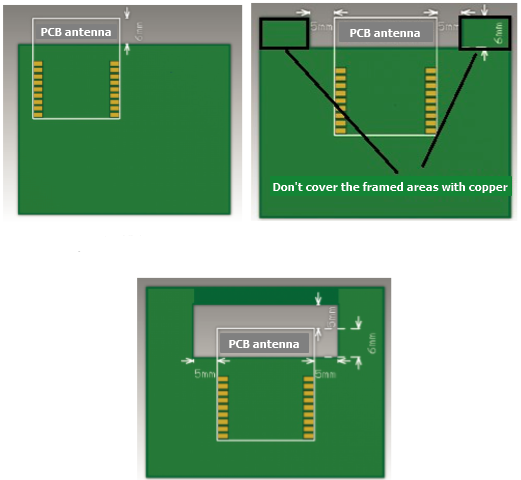
Packaging information and production instructions
Mechanical dimensions



The following is the schematic diagram of BF6H-M which shows how pins correspond to each other:
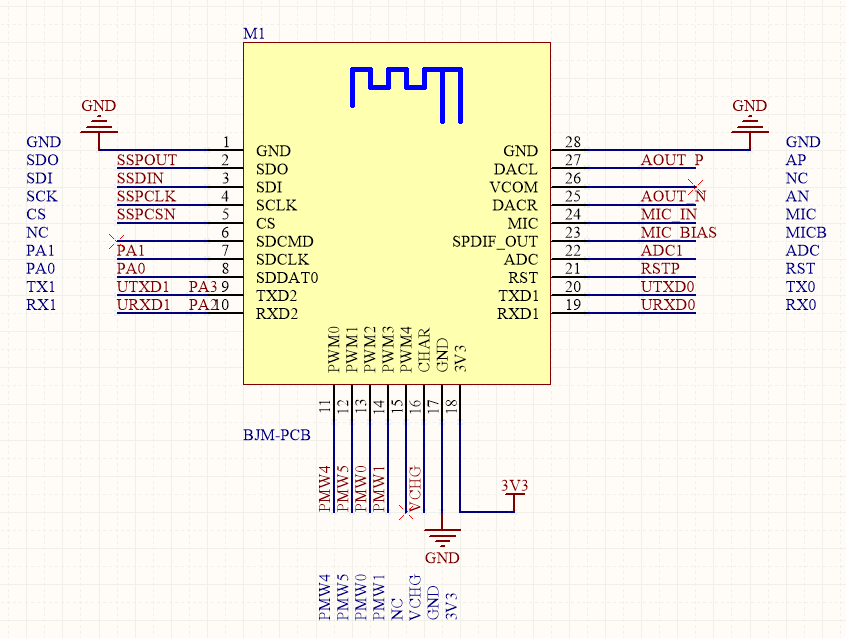
Recommended PCB footprint:
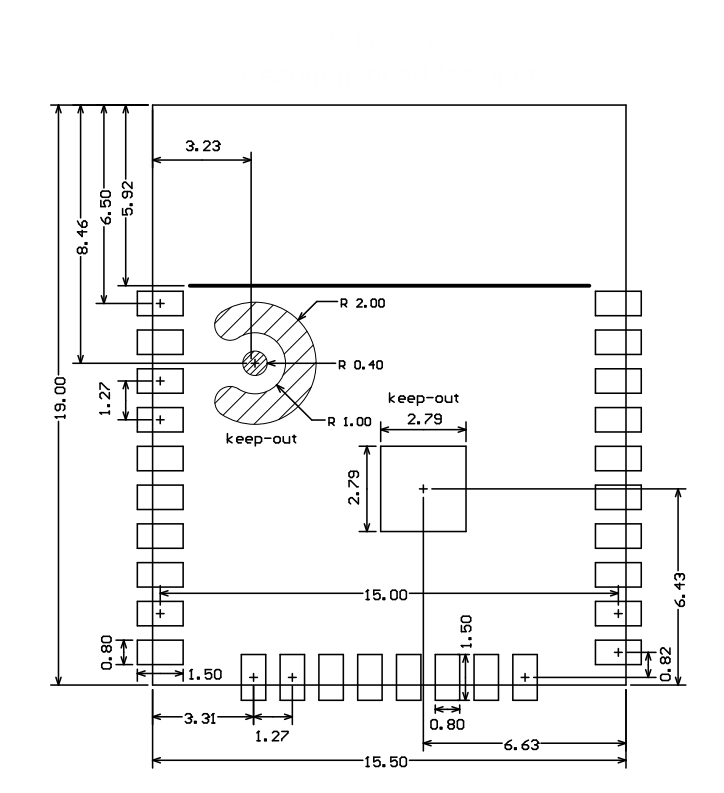
The default outline dimension tolerance is ±0.35 mm, and the critical dimension tolerance is ±0.1 mm. If you have specific requirements on dimensions, specify them clearly in the datasheet after communication.
Production instructions
- For the Tuya in-line module, wave soldering is most preferred and manual soldering is less preferred. After being unpacked, the module must be soldered within 24 hours. Otherwise, it must be put into the drying cupboard where the RH is not greater than 10%; or it needs to be packaged under vacuum again and record the exposure time (the total exposure time cannot exceed 168 hours).
- Wave soldering devices and materials:
- Wave soldering equipment
- Wave soldering fixture
- Constant-temperature soldering iron
- Tin bar, tin wire, and flux
- Thermal profiler
- Baking devices:
- Cabinet oven
- Anti-electrostatic and heat-resistant trays
- Anti-electrostatic and heat-resistant gloves
- The module needs to be baked in the following cases:
- The packaging bag is damaged before unpacking.
- There is no humidity indicator card (HIC) in the packaging bag.
- After unpacking, circles of 10% and above on the HIC become pink.
- The total exposure time has lasted for over 168 hours since unpacking.
- More than 12 months have passed since the sealing of the bag.
- Baking settings:
- Temperature: 60°C and ≤ 5% RH for reel package and 125°C and ≤5% RH for tray package (please use the heat-resistant tray rather than plastic container)
- Time: 48 hours for reel package and 12 hours for tray package
- Alarm temperature: 65°C for reel package and 135°C for tray package
- Production-ready temperature after natural cooling: < 36°C
- Re-baking situation: If a module remains unused for over 168 hours after being baked, it needs to be baked again.
- If a batch of modules is not baked within 168 hours, do not use the wave soldering to solder them. Because these modules are Level-3 moisture-sensitive devices, they are very likely to get damp when exposed beyond the allowable time. In this case, if they are soldered at high temperatures, it may result in device failure or poor soldering.
- In the whole production process, take electrostatic discharge (ESD) protective measures.
- To guarantee the quality of products, you must pay attention to the following items: The amount of soldering flux, the height of the wave peak, whether the tin slag and copper content in the wave soldering tank exceed standards, whether the window and thickness of the wave soldering fixture are appropriate, and whether the wave soldering oven temperature curve is appropriate.
Recommended oven temperature curve and temperature
Set oven temperatures according to the following temperature curve of wave soldering. The peak temperature is 260°C±5°C.
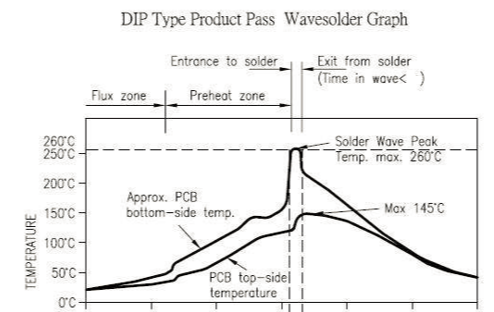
Recommended soldering temperature:
| Suggestions on oven temperature curve of wave soldering | Suggestions on manual soldering temperature | ||
|---|---|---|---|
| Preheat temperature | 80 to 130 °C | Soldering temperature | 360±20°C |
| Preheat time | 75 to 100s | Soldering time | <3s/point |
| Peak contact time | 3 to 5s | NA | NA |
| Temperature of tin cylinder | 260±5°C | NA | NA |
| Ramp-up slope | ≤2°C/s | NA | NA |
| Ramp-down slope | ≤6°C/s | NA | NA |
Storage conditions
Storage conditions for a delivered module:
-
The moisture-proof bag is placed in an environment where the temperature is below 40°C and the relative humidity is lower than 90%.
-
The shelf life of a dry-packaged product is 12 months from the date when the product is packaged and sealed.
-
There is a humidity indicator card (HIC) in the packaging bag.
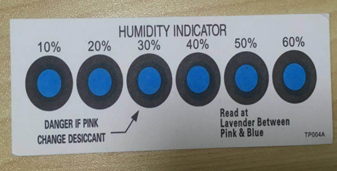

MOQ and packaging information
| Product model | MOQ (pcs) | Packing method | Modules per reel | Reels per carton |
|---|---|---|---|---|
| BF6H-M | 4400 | Tape reel | 1100 | 4 |
Appendix: Statement
FCC Caution: Any changes or modifications not expressly approved by the party responsible for compliance could void the user’s authority to operate this device.
This device complies with Part 15 of the FCC Rules. Operation is subject to the following two conditions: (1) This device may not cause harmful interference, and (2) this device must accept any interference received, including interference that may cause undesired operation.
This device has been tested and found to comply with the limits for a Class B digital device, according to part 15 of the FCC Rules. These limits are designed to provide reasonable protection against harmful interference in a residential installation. This device generates, uses, and can radiate radio frequency energy and, if not installed and used following the instructions, may cause harmful interference to radio communications. However, there is no guarantee that interference will not occur in a particular installation.
If this device does cause harmful interference to radio or television reception, which can be determined by turning the device off and on, the user is encouraged to try to correct the interference by one or more of the following measures:
- Reorient or relocate the receiving antenna.
- Increase the separation between the device and receiver.
- Connect the device into an outlet on a circuit different from that to which the receiver is connected.
- Consult the dealer or an experienced radio/TV technician for help.
Radiation Exposure Statement
This device complies with FCC radiation exposure limits set forth for an uncontrolled rolled environment. This device should be installed and operated with a minimum distance of 20cm between the radiator and your body.
Important Note
This radio module must not be installed to co-locate and operate simultaneously with other radios in the host system except following FCC multi-transmitter product procedures. Additional testing and device authorization may be required to operate simultaneously with other radios.
The availability of some specific channels and/or operational frequency bands are country dependent and are firmware programmed at the factory to match the intended destination. The firmware setting is not accessible by the end-user.
The host product manufacturer is responsible for compliance with any other FCC rules that apply to the host not covered by the modular transmitter grant of certification. The final host product still requires Part 15 Subpart B compliance testing with the modular transmitter installed.
The end-user manual shall include all required regulatory information/warnings as shown in this manual, including “This product must be installed and operated with a minimum distance of 20 cm between the radiator and user body”.
This device has got an FCC ID: 2ANDL-BF6H-M. The end product must be labelled in a visible area with the following: “Contains Transmitter Module FCC ID: 2ANDL-BF6H-M”.
This device is intended only for OEM integrators under the following conditions:
The antenna must be installed such that 20cm is maintained between the antenna and users, and the transmitter module may not be co-located with any other transmitter or antenna.
As long as the 2 conditions above are met, further transmitter tests will not be required. However, the OEM integrator is still responsible for testing their end-product for any additional compliance requirements required with this module installed.
Declaration of Conformity European Notice

Hereby, Hangzhou Tuya Information Technology Co., Ltd declares that this module product complies with essential requirements and other relevant provisions of Directive 2014/53/EU, 2011/65/EU. A copy of the Declaration of conformity can be found at https://www.tuya.com.

This product must not be disposed of as normal household waste, under the EU directive for waste electrical and electronic equipment (WEEE-2012/19/EU). Instead, it should be disposed of by returning it to the point of sale, or a municipal recycling collection point.
The device could be used with a separation distance of 20cm to the human body.
Is this page helpful?
YesFeedbackIs this page helpful?
YesFeedback





